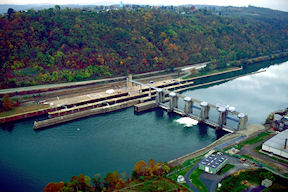
 The Ohio River originates at the “Forks of the Ohio,” the historical name for the confluence of the Allegheny and Monongahela Rivers at Pittsburgh, PA. The image above depicts this location, which is known as the “Point,” as it appeared around 1920, when the factories and mills were still operating. The image on the left is a contemporary view of the Point, sans the heavy industry of yesteryear.
The Ohio River originates at the “Forks of the Ohio,” the historical name for the confluence of the Allegheny and Monongahela Rivers at Pittsburgh, PA. The image above depicts this location, which is known as the “Point,” as it appeared around 1920, when the factories and mills were still operating. The image on the left is a contemporary view of the Point, sans the heavy industry of yesteryear.
The Locks
 The Pittsburgh District of the US Army Corps of Engineers operates 23 locks and dams on the Allegheny, Monongahela and Ohio Rivers. Lock #4 on the Monongahela River is about 30 miles south of Pittsburgh near Charleroi, PA.
The Pittsburgh District of the US Army Corps of Engineers operates 23 locks and dams on the Allegheny, Monongahela and Ohio Rivers. Lock #4 on the Monongahela River is about 30 miles south of Pittsburgh near Charleroi, PA.
In addition to Charleroi, there is another town a bit south of Lock #4 named Monessen. Charleroi was home to a glass factory and takes its name from Charleroi, Belgium, which was a major producer of glass products…and a lot of the original glassworkers were indeed Belgian immigrants. Monessen had steel mills and a cast iron foundry. It is named after the Monongahela (i.e., Mon) River and Essen, Germany, which was at the time a major steel production center. One of the major reasons for locating the factories along the rivers was the need for a low-cost, dependable way to transport the primary energy source needed to run the factories, which was coal. Southwestern Pennsylvania and neighboring West Virginia had large deposits of soft, or bituminous, coal, much of which was transported from the coal mines to the factories by river barge. Hence the need for the locks and dams to make sure the river maintained a minimum depth of nine feet, which was needed to make it navigable for steamboats pushing barges filled with coal.
Epilog
If you’ve bothered to read this far, here’s the reason this piece of trivia exists. My hometown was Monessen and my wife’s hometown was Charleroi. Back in the day, our fathers, uncles, other relatives, and the majority of their contemporaries worked in the steel mills, foundries, glass factories, and coal mines in or near the small towns dotting the riverbanks of the “Mighty Mon.”